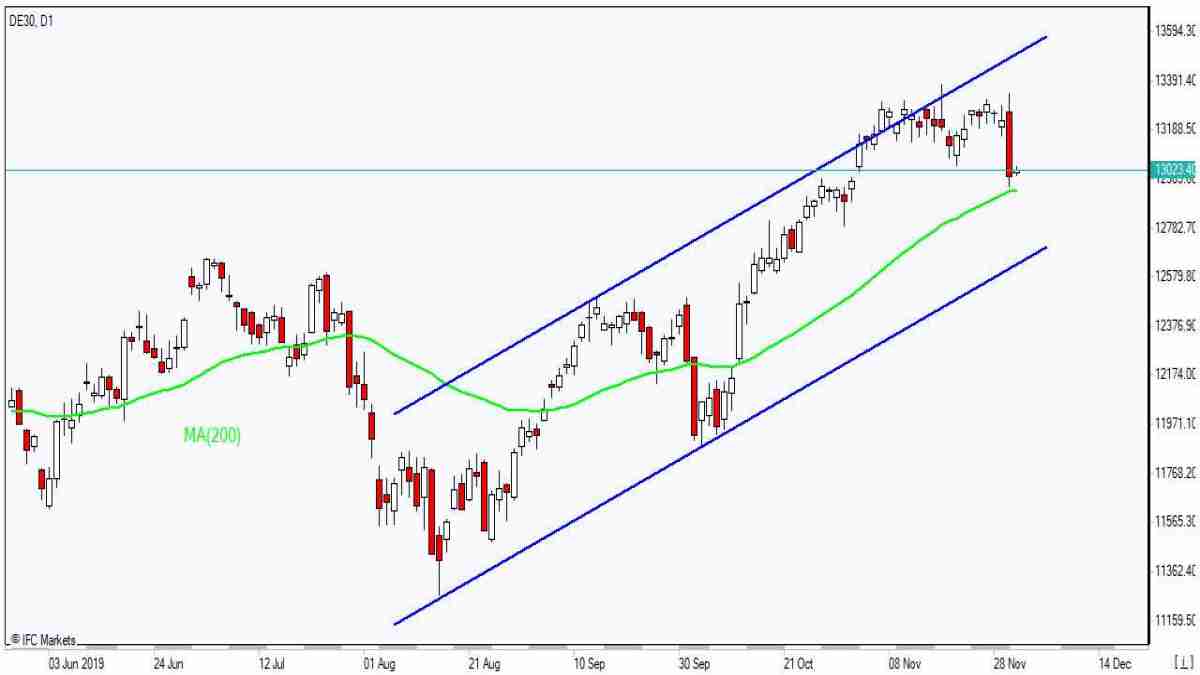Dollar strengthening halted
US stocks pullback deepened on Monday with investor optimism undermined by weak data and lingering trade uncertainty. The Office of the US Trade Representative threatened to impose tariffs of up to 100% on about $2.4 billion in French imports. The S&P 500 finished 0.85% lower at 3113.87. Dow Jones industrial fell 0.96% to 27783.04. The Nasdaq slumped 1.1% to 8567.99. The dollar weakening accelerated as data showed the Institute for Supply Management’s purchasing manager’s index unexpectedly fell to 48.1 in November from 48.3 in the previous month. The live dollar index data show the ICE US Dollar index, a measure of the dollar’s strength against a basket of six rival currencies, slid 0.3% to 98.28 and is lower currently. Futures on three main US stock indices indicate higher openings today.
European stocks fall third straight session
European stock indexes retreat broadened on Monday as president Trump tweeted he “will restore the Tariffs on all Steel & Aluminum” that Brazil and Argentine ship to US. Both the EUR/USD and GBP/USD speeded up their climb yesterday with euro reversing currently while Pound higher still. The Stoxx Europe 600 index ended 1.6% lower as Markit reported euro zone manufacturing activity shrank for the tenth month in a row in November. The DAX 30 fell 2.1% to 12964.68. France’s CAC 40 lost 2% while UK’s FTSE 100 slid 0.85% to 7285.94.
Australia’s All Ordinaries Index leads Asian indexes losses
Asian stock indices are mixed today as trade concerns rose following US threat to impose tariffs on steel imports from Brazil and Argentine. Nikkei fell 0.6% to 23,379.81 despite resumed yen decline against the dollar. Markets in China are mixed as Beijing announced sanctions Monday against several US non-government organisations for supporting Hong Kong protesters: the Shanghai Composite Index is up 0.3% while Hong Kong’s Hang Seng Index is 0.3% lower. Australia’s All Ordinaries Index dropped 2.1% as Australian dollar continued climbing against the greenback following central bank’s decision to hold policy steady while the current account surplus widened in Q3.
Brent gaining
Brent futures prices are extending gains today. Prices rose yesterday after Iraq’s oil minister remarks over the weekend that OPEC and its allies would consider deepening cuts by 400,000 barrels a day to 1.6 million barrels: January Brent crude closed 0.7% higher at $60.92 a barrel on Monday.
Want to get more free analytics? Open Demo Account now to get daily news and analytical materials.
This overview has an informative character and is not financial advice or a recommendation. IFCMarkets. Corp. under any circumstances is not liable for any action taken by someone else after reading this article.
Recommended Content
Editors’ Picks
AUD/USD could extend the recovery to 0.6500 and above

The enhanced risk appetite and the weakening of the Greenback enabled AUD/USD to build on the promising start to the week and trade closer to the key barrier at 0.6500 the figure ahead of key inflation figures in Australia.
EUR/USD now refocuses on the 200-day SMA

EUR/USD extended its positive momentum and rose above the 1.0700 yardstick, driven by the intense PMI-led retracement in the US Dollar as well as a prevailing risk-friendly environment in the FX universe.
Gold struggles around $2,325 despite broad US Dollar’s weakness

Gold reversed its direction and rose to the $2,320 area, erasing a large portion of its daily losses in the process. The benchmark 10-year US Treasury bond yield stays in the red below 4.6% following the weak US PMI data and supports XAU/USD.
Bitcoin price makes run for previous cycle highs as Morgan Stanley pushes BTC ETF exposure

Bitcoin (BTC) price strength continues to grow, three days after the fourth halving. Optimism continues to abound in the market as Bitcoiners envision a reclamation of previous cycle highs.
US versus the Eurozone: Inflation divergence causes monetary desynchronization

Historically there is a very close correlation between changes in US Treasury yields and German Bund yields. This is relevant at the current juncture, considering that the recent hawkish twist in the tone of the Federal Reserve might continue to push US long-term interest rates higher and put upward pressure on bond yields in the Eurozone.
